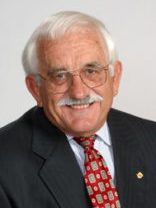If anyone is qualified to write a history of our roads, long time Manningham resident
Dr Maxwell Lay would have to be near the top of the list. His career includes leadership roles at the Australian Road Research Board and VicRoads, he was an independent reviewer for the Melbourne City Link Project and Chairman of the Royal Automobile Club of Victoria.
Here, Dr Lay shares a fascinating journey through the history of our highways and byways:
The first settlers in the Manningham area grazed cattle on the south bank of the Yarra from Bulleen to Hawthorn and by 1838 had established sheep farms in the area’s fertile riverside flats in Bulleen and Templestowe. Just downstream, the Bolin Bolin Billabong was a favoured campsite for the Indigenous community.
Both groups needed to travel downstream to the lower reaches of the Yarra - the obvious route was to stay on firm ground and cross the Koonung Creek near today’s Bulleen Road crossing. From there, a shortcut avoiding the many twists of the river followed a relatively straight line south-west close to the path of today’s Bulleen Road in North Balwyn, High Street in Kew and Church Street in Hawthorn.
For settlers, a common crossing of the Yarra was at Bridge Road in Richmond. Whilst we may assume that the settlers and their flocks followed pre-existing tracks created and used by the Indigenous peoples, cattle and sheep quickly destroyed any signs of such tracks. Wheeled vehicles also demanded something broader than metre-wide tracks, so Bulleen Road from Finns Reserve at Templestowe to Koonung Creek at North Balwyn would have been our first road.
On the other side of the river, early settlers with good resources had established major properties at Heidelberg and by 1840 a road had been established on the north bank of the Yarra linking Heidelberg and Melbourne. Early Bulleen residents would often have crossed the Yarra near Banksia Street, by 1839 a ferry was operating there and the first bridge was built in 1860.
Settlement of the area continued and by the 1850s there were extensive orchards in Doncaster, creating more need to travel to and from Melbourne. Using the Banksia Street crossing of the Yarra to join Heidelberg Road and head downstream remained popular and Manningham Road developed to service this Banksia Street traffic.
Manningham Road is a ridge road and used a ridge which linked it to Doncaster Road and then to Mitcham Road. Many pre-car roads were ridge roads and it was easy to see their appeal - they were never swampy and usually had a firm surface, the land itself was relatively cheap and you could see where you were. As you drive along them today, you can see how all the side streets on both sides of a ridge road such as Manningham Road slope downhill away from the road.
The main alternative to Banksia Street for travellers from Melbourne was to cross the Yarra at the east end of Bridge Road in Richmond, then use High Street, Kew to link up with Doncaster Road in North Balwyn, also a ridge road, before dropping down to a crossing of the Koonung Creek in Greythorn and then climbing the steep hill to today’s Westfield Doncaster. The hill was a challenge in pre-car days and some travelers used the High Street ridge road in Templestowe for a more gradual climb to Manningham Road.
Travellers to Templestowe soon created Thompsons Road as a short cut to avoid Bulleen Road as it meandered along the riverside. Encouraged by the goldrush, a toll bridge over the Yarra linking Thompsons Road to Bonds Road in Eltham operated from 1855 to 1863.
Doncaster Road gained more importance with the discovery of gold in Warrandyte and in the mountains beyond Healesville in the 1850s. A common route to Healesville used Doncaster Road, Mitcham Road and the Maroondah Highway as it avoided swampy conditions in Balwyn.
The gold rush meant Doncaster Road now split into a variety of tracks east of Blackburn Road. One appears to have headed northeast and used the southern end of today’s Anderson Creek Road to cross Mullum Mullum Creek near Reynolds Road.
Another route to the goldfields left Doncaster Road on a route approximating today’s Old Warrandyte Road and crossed Mullum Mullum Creek closer to the Tindalls Road crossing. It then proceeded near the line of Stintons and Falconer roads to Andersons Creek and Warrandyte. Indeed, an early name for Doncaster Road was Andersons Creek Road.
Templestowe Village was established in 1852. It was reached by Templestowe Road as an extension of Bulleen Road and then by High Street as a ridge road down from Doncaster Road. Access via Williamsons Road came later as it required very steep climbs out of the Mullum Mullum Creek valley, only practical as the motor car developed. Surveyed in 1855, the route was named after local landowner Robert Williamson, who donated land to the Church of Christ in 1864. At its northern end Fitzsimons Lane is shown as a road reservation 1854 maps and named after Fitzsimon, another early local land owner.
Source: Manningham Matters June 2021 Original Format. Permission granted by Max Lay to publish on website July2021



No comments:
Post a Comment